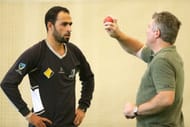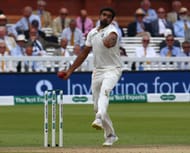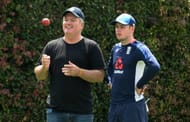
"He had a great attitude and was more of a snarling fast bowler than thoughtful spinner."
Shane Warne, in his autobiography 'No Spin', described Stuart MacGill, or Magilla, as a 'rage that needed to be dogged'. Batsmen must have shared the sentiment, for MacGill, on his best day, was a hard nut to crack, giving the ball a ridiculous rip.
In part two of this conversation with Sportskeeda, MacGill talks about the current crop of wrist spinners, why the particular species is dominating world cricket, and more.
Do you believe wrist spinners have reinvented themselves for the shortest format of the game?
I don't think they have exactly reinvented themselves. T20 cricket has just realised how important a wrist spinner is. Doesn't matter if you are left or right, wrist spin is a dynamic form of bowling in short form cricket.
Quite aside from the variations (googlies, sliders etc), even if you bowl a stock ball, and if you get lots of work on the ball, you can force the batsman to hit in certain areas. That's why wrist spinners are so valuable in T20 cricket.
The hardest thing for a spinner to do is to get a batsman to play a shot. When you bowl slow, someone who has never picked a bat before can also hit the ball. Even my grandmother would hit me for a six!
When bowling to a great batsman, it doesn't matter how much you turn or dip or drift. It is a hard job.
You don't have to force the guy to play the shot. He has to go for it every single time. That's the reason why spinners do well in short-form cricket.
Young wrist spinners are ruling the roost in white ball cricket globally. What's your take on the current crop?

I have spent a lot of time with Adam Zampa. I love him. You can imagine coming from a country like Australia, following in the footsteps of Shane Warne. People just compare to him, and you have to be exactly like him, otherwise you're no good.
Zampa knows what he can and cannot do. He has a plan when he bowls, he rarely bowls a bad ball. That doesn't mean that everyday is a good day, because sometimes the batsman can still get on top of you. He is calm, and confident in what he's doing.
He should be very very proud of himself, he is a very very good player.
Yasir Shah is an absolute superstar. Rashid Khan is a good kid, so is Adil Rashid.
My only concern is when they go into regular T20 tournaments, I get worried when they try to keep the runs down. The best way to keep runs down is to bowl the team out. That can be a Test match, or a T20 game.
I don't like when they start bowling wrong 'uns into leg stump to a right-hander. The best way to play is to bowl your stock ball and bowl as well as you can, and believe you can bowl the other team out.
A wrong 'un to a right hander should hit the top of off stump, it doesn't matter what format.
I love Kuldeep Yadav. He's so cool. I love it when they bowl their best ball - they might get hit for a six, but is the batsman good enough to hit two in two, or three in a row for a six?
If you bowl your best ball, and believe in it, you win most games. That's why wrist spin bowlers are so important.
I can add to the list Fawad Ahmed, he should have played Tests for Australia.

He has maturity and age now - even if he gets hit, he goes to the top of his mark and does it again. That's what makes him a good bowler.
Also, wrist spinners are much better looking!
We spoke about spinners getting defensive when going for runs. What are the challenges young spinners face early in their career?
You get embarrassed as you move up in quality (club, to first-class, to Test). As juniors, 10 or 12-year-old kids are not very strong, and sometimes spinners chuck the ball way up in the air and it is very difficult to hit them. It doesn't mean they are that they are good bowlers, but they get a lot of wickets.
When they get higher through the grades, and the batsman sees one being chucked up in the air, and it goes for a six, the bowlers get shocked - they are embarrassed, they make excuses. They lose interest. It is a very difficult time for a young spin bowler.
You almost have to ignore everything else that is going on. When I coach, I tell the guys it's - very similar to a penalty kick in football.
You put the ball on the spot, you prepare as you want to prepare and you kick it. If the keeper saves it, doesn't necessarily mean you haven't done your job well. It's the same when you're bowling.
After I have let go, I can't do anything about it. It's completely a set play. Young spinners are way too hard on themselves. That's the big thing - if the batsman hits you for a six, doesn't mean you have done anything wrong.
It's a hard, hard road for young spin bowlers. Particularly nowadays, kids like to look cool. And if won't look cool if you're bowling.
There's a lot of debate regarding wrist spinners and finger spinners. Do you think finger spinners are slowly losing their grasp in white-ball cricket, especially with the increased clamour for wrist spinners?
I am biased because I am a wrist spinner. The big thing with playing cricket is that if you are swing bowler, you swing, if you are a pacer, you bowl fast. If you are a spinner, you need to have revolutions on the ball.
What I feel with a lot of finger spinners in world cricket, especially in the short format is that they just attack the stumps.
You can attack the stumps with work on the ball, or you can attack by just bowling straight and slow. If you are running your fingers underneath the ball, or if you are bowling round arm or skidding the ball through, you are realistically getting the batsman out only if they're making mistakes.
When you are bowling wrist spin, if you have revolutions on the ball, it doesn't need to turn sideways a lot. If it is spinning through the air quickly, the revolutions are good, then there is a chance you can deceive the batsman. In terms of deception, wrist spinners win 99 out of 100 times.
We have the capacity to deceive the batsman, where the finger spinners have control to wear a batsman down.
What if you try and squeeze in one of each in your team...
Maybe, but I would prefer having 11 guys in my team who are all matchwinners.
One of the biggest tragedies was that Ravichandran Ashwin got injured on the Australian tour. He has got a great wrist, but in India he can rely on what happens off the pitch, whereas outside you have to deceive through the air.

From what I saw in the first Test, if he had been playing the entire series, it would have been much easier for India.
That's the best I have ever seen in him bowl. Forget about all the wickets and all his statistics. He was deceiving batsmen through the air. If a finger spinner can do that, they are in the same game.
The advantage that wrist spinners have, is that they have more revolutions, the ball does more through the air. It's not as much off the pitch. People talk about how much I turn the ball, but if the batsman hits it on the full, it doesn't spin at all!
It is about deceiving the batsman through the air. Finger spinners can do it, it's a little more difficult.
You have been into coaching post-retirement. What is the most important advice you give to young spinners?

I coach a lot of spinners around the place, a lot of the English guys. The ECB sends a number of spinners to Sydney each summer. Matt Parkinson, Matt Critchley, Mason Crane, Joshua Poysden - a lot of their first-class players have come out here.
The guy I am working with is Ish Sodhi, I was in Hamilton with him before he went to play for the Rajasthan Royals. I work with him very closely, he is like a little brother.
I really enjoy coaching. I never thought I would be into it. It's the next best thing to playing. Spin bowling wasn't natural to me. It took me a lot of time to get. I had to work hard.
When I played County, what really improved was my consistency and I understood my game a lot better. It is important for youngsters to play more and more, in different conditions. In Australia, we are sending a lot of our cricketers around the world to experience different environments.
I had lots of bad days. I got wickets in Test cricket with chest-high full tosses. It's embarrassing. That's what you will be able to cope with. The fact that I have been through all and tried to keep a straight face. I am a proud man. I am helpful for young players.
Walking into the field for the first time, imagine how that would be like. You have a billion people watching you do one of the most difficult things to do. bowl slow to a batsman who can hit you for a six anytime he wants. It is a terrifying prospect. People don't appreciate that.
I can help guys cope with that sort of stuff. Even if they get hit and are embarrassed, I can help them walk back and bowl again. If a batsman makes a mistake, he's out. If a bowler makes a mistake, he can go back to his bowling mark, start again and bowl the next ball.
When I talk to young guys, not the spinners, but to kids, you just try and bowl the best ball.
For me, it is all about the next ball.
Follow IPL Auction 2025 Live Updates, News & Biddings at Sportskeeda. Get the fastest updates on Mega-Auction and cricket news
